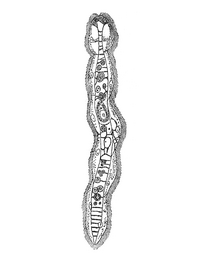Rhombozoa facts for kids
Quick facts for kids Rhombozoa/Dicyemida |
|
|---|---|
 |
|
| Scientific classification | |
| Kingdom: | |
| Superphylum: | |
| Phylum: |
Rhombozoa
van Beneden, 1876
|
| Families | |
|
|
The Rhombozoa, also known as Dicyemida, are a group of very tiny creatures. They are a type of parasite, which means they live inside another animal and get their food from it. These tiny parasites make their home in the kidney-like parts of cephalopods. Cephalopods are ocean animals like octopuses, squids, and cuttlefish.
Scientists are still learning about Rhombozoa and how they fit into the animal kingdom. Many think they might be a completely new phylum. A phylum is a major group of animals, like how all vertebrates (animals with backbones) are in one phylum. For a long time, Rhombozoa were grouped with another small group called Orthonectida. But new studies looking at their DNA suggest they might be more closely related to roundworms.
What Do Rhombozoa Look Like?
Adult Rhombozoa are very small, usually between 0.5 and 7 millimeters long. This means you can see them if you use a microscope. Each adult of a specific type of Rhombozoa always has the exact same number of cells. This special feature is called eutely. Knowing the number of cells helps scientists tell different types of Rhombozoa apart.
Their bodies are quite simple. They have one main cell in the middle, called the axial cell. This central cell is surrounded by about 20 to 30 other cells. These outer cells have tiny hair-like structures called cilia that help them move.
How Do Rhombozoa Live and Reproduce?
Rhombozoa have an interesting life cycle because they can reproduce in two different ways: asexually (without a partner) and sexually (with a partner). The way they reproduce depends on the age of the cephalopod they live in.
When the cephalopod host is young or still growing, the Rhombozoa inside it reproduce asexually. At this stage, they are called nematogens. These nematogens create worm-like larvae inside their central cell. These larvae grow directly into more nematogens, filling up the cephalopod's kidneys.
Later, as the cephalopod host gets older and becomes an adult, the Rhombozoa change. They become rhombogens, which are the sexual forms. Rhombogens are special because they are hermaphrodites, meaning they have both male and female reproductive parts. They can fertilize themselves. After self-fertilization, the rhombogens release new larvae, which then continue the life cycle.
Images for kids
See also
 In Spanish: Rombozoos para niños
In Spanish: Rombozoos para niños


